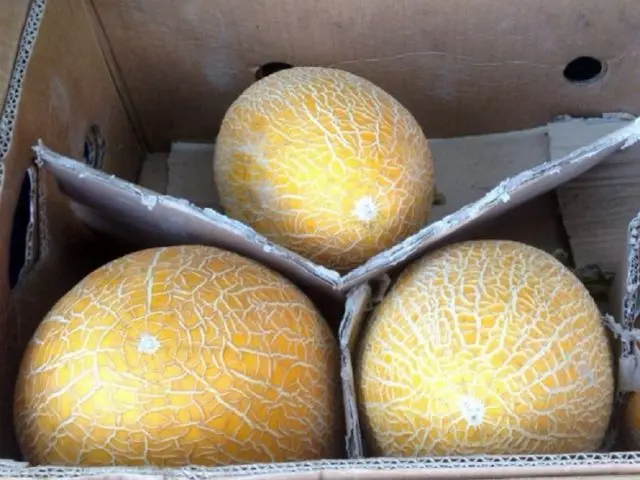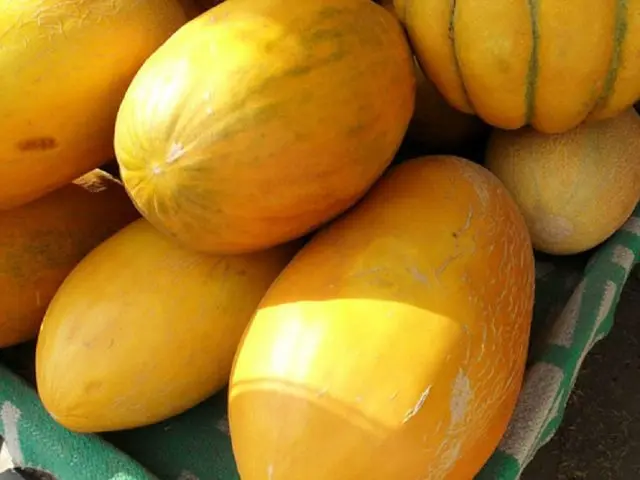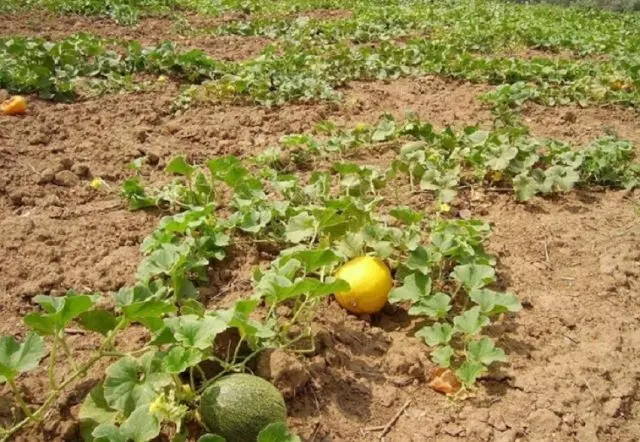Contents
Despite the huge number of species, the Turkmenka melon is especially loved by summer residents. This culture has an amazing taste and aroma. You can grow a good melon crop not only in the southern strip. By following certain agrotechnical rules, it is quite possible to get a crop of ripe Turkmenka even in Siberia.

Description of melon Turkmenka
Melon Turkmenka is not a separate variety, but a whole group of pumpkin species. This term is used for melons grown in the region of the same name. The Turkmen in the stage of full maturation rarely has a large size. However, her characteristics are excellent:
- sweet taste;
- juicy pulp;
- aroma of freshness.
In addition, Turkmenka melon is valued for its good resistance to low temperatures. When the variety ripens, the characteristic peel on the mesh darkens, turns brown and is visually pressed inwards.
Varieties of Turkmen melons
It should be noted that “Turkmenskaya” is a large group of varieties, uniting about 400 names. It is divided into 4 main sections, each of which has a different ripening period:
- Early maturing or precocious. The vegetation period of this subgroup of the Turkmen woman lasts 60-70 days. Famous representatives are Mazy, Ternek, Zamcha. They are distinguished by high juiciness, delicate taste and persistent aroma. Sugar content in the range of 10-15%.
- The middle-ripening – the second subgroup, characterized by a longer ripening period of 75-95 days. It includes varieties Mesek and Vaharman. Their flesh is denser, slightly crispy, juicy and sweeter than that of early-ripening Turkmen melons. Sugar content from 15% to 18%. Most often used by cooks for drying.
- Mid-late – the third subgroup with a ripening period of 95 to 105 days. The most famous of them are Garry-Gyz and Payandaki. They differ even more dense and sweet pulp, even a little viscous. The fruits of the late Turkmenka are well stored, used for drying, canning, making melon honey. Sugar content of 18% or more. They are considered universal varieties. They tolerate transportation well, so they are sold fresh in different regions.
- late ripening – the fourth subgroup of giant melons. The main representatives of Aktash and Almagulaby. Reach huge sizes, the vegetative period from 100 to 120 days. One ripe Turkmen melon weighs 15-20 kg. Feature – no strong saturation of taste, very high pulp density, resistance to low temperatures. Varieties of the subgroup are grown even in Siberia.

How to choose a melon Turkmenka
You need to choose a ripe fruit with knowledge of the matter. There are certain signs of a quality melon that should be present in the selected specimen:
- Smell. Ripe melon Turkmenka has a delicate pleasant aroma. If there is no smell when buying, you do not need to take it. The fruit will be unsweetened and juicy.
- Sound. When clapped with the palm of the hand, a ripe Turkmenka melon makes a dull sound. If the fruit is unripe, then the buyer will hear a loud pop.
- Skin condition. It should not be soft and pressed through. It is best to choose a melon with an elastic skin.
- Color. The peel of a ripe melon Turkmenka is colored in a rich yellow color without dark spots or greenish halos.
- Tail state. It must be dry.
Additionally, you can ask the seller to choose a good copy, and then test it according to the listed features.
Growing Turkmen
Turkmenka belongs to the late varieties of melon. Due to the long growing season in the middle lane and the northern region, it is possible to grow a crop only in seedlings. It is very convenient to use a collapsible greenhouse in the garden, which is removed after the end of the return frost.
There is a trellis method of growing Turkmen melon, in which the lashes of the plant are tied to the frame. In this state, the fruits are well illuminated by the sun. But most often, plants are grown in raised, spreading lashes on the ground.
Preparation of seedlings
You can grow a Turkmen woman in the middle lane using a seedling method. This technique allows you to shorten the growing season and get a ripe fruit. There are several rules that vegetable growers need to follow in order for seedlings to grow strong:
- Do not violate the deadline for sowing Turkmenka. For the middle lane, the best time is mid-March or the end of April, depending on climatic conditions.
- Choose your seeds wisely. We need high-quality Turkmen seeds that have lain for 2-3 years, even if they are hybrid varieties.
- Get good quality soil. You can use ready-made soil for pumpkin plants, which is sold in a specialized store. If you cook on your own, you will need to prepare a mixture of river sand (10 kg), peat (9 kg), humus (10 kg) and wood ash (200 g).
- Choose a suitable container. Plastic containers or peat pots with drainage holes are best. The Turkmen melon does not tolerate transplanting well, it is better to immediately take containers with a diameter of at least 10 cm. A container from which seedlings can be obtained with a clod of earth will be ideal.
Seeds (2 pcs. per 1 cup) deepen by 1,5 cm. Moisten, cover the container with a film. After the emergence of shoots of melons, place in the light, water every other day.
The temperature is maintained at + 20-25 °С during the day and + 18-20 °С at night.

The first dressing of seedlings of Turkmenka should be carried out in the phase of 2 true leaves with complex fertilizer, then repeat in the same composition after 2 weeks.
2-3 weeks before planting, be sure to start hardening melon seedlings.
Selection and preparation of the landing site
For the beds, you should choose an open sunny area, but protected from the wind. Melon grows well on the southern slopes.
The Turkmen woman prefers soil with neutral acidity. It reacts worst of all to souring and high soil moisture. Before planting, the soil should be “deacidified” if the neutrality does not match the required one.
In autumn, it is necessary to dig up the site with the simultaneous introduction of humus or compost with the addition of superphosphate.
Rules of landing
As soon as 5-7 leaves form on the seedlings of the Turkmenka, it’s time to plant the seedlings in the ground. First, you need to moisten the containers with seedlings so that they can be taken out well. Prepare holes in advance at a distance of 55 cm from each other.
Plants should be transplanted together with a clod of earth, then immediately pour settled water. While the sprouts take root, you will have to water with heated water. Do not deepen the root neck, otherwise the Turkmenka will be susceptible to fungal infections.
The landing date is scheduled for the time when the night temperature in the region does not fall below + 14 ° C. After transplantation, Turkmenka seedlings are shaded for 2-3 days.
To increase the yield of Turkmenka, the main shoot is pinched over the 4th leaf. The regrown 2 lateral shoots are flattened on the ground and pinned.
Watering and top dressing
Melon loves regular watering, but waterlogging leads to rotting of the root system. Therefore, when watering, you should monitor the condition of the soil.
For fertilizing the Turkmen melon, liquid organic fertilizers and mineral complexes are used. For a more effective result, it is recommended to alternate them. The first time you should feed the plants 2 weeks after planting, then during the formation of side shoots and before the appearance of buds. At the same time, it is important to adhere to the rules for fertilizing for garden crops. Particular attention should be paid to the amount of nitrogen components. If they are overdosed, then there will be an increase in the growing season of the melon, a delay in fruiting.
Formation
In the open field, the formation of the Turkmenka melon is carried out by pinching the apical buds of the lashes. If the procedure is performed correctly, the nutrients from the roots begin to flow not into the whip, but immediately into the fetus. Melons grow bigger and sweeter. Of course, subject to the schedule of watering and fertilizing.
Harvesting
The collection time of the Turkmen melon is determined by the further appointment of the fruit. For fresh use, fully ripe specimens are needed. If there is a short transportation or storage, then melons are selected 2 days before full ripening. Late-ripening varieties are subject to long-term storage, which are harvested at the stage of technical ripeness. Such melons are already fully formed, but at least another week should pass before full maturity. Any green or overripe fruit is not suitable for storage. The ripeness of a melon is determined by:
- Intense aroma. The ripe fruit has a persistent melon smell.
- Skin change. If the variety is distinguished by the presence of a mesh on the peel, then it acquires a clear expression and a darker color, visually, as it were, is pressed inward. When the variety is without a mesh on the peel, then ripeness is determined by the rich yellow color of the fruit.
- Ease of separation from the stem. At the moment of maturity of the fetus, the stalk begins to dry out.
The collection of melons takes place in stages and selectively. The fruits do not ripen at once, so ripe ones are gradually harvested at intervals of 5-6 days.

You need to pluck the fruits with a stalk 4-5 cm long. It is better to schedule harvesting in the morning or evening. It is important that there is no active sun.
Spread the plucked fruits of the Turkmenka on the ridges and leave in the sun for 10-14 days, turning after 5-6 hours.
Diseases and pests
Landings of Turkmenka are exposed to infections of any etymology – viral, bacterial, fungal. The source is seed, contaminated soil, vector plants or insects. The main preventive measures will be:
- Careful observance of the requirements of agricultural technology.
- Pre-sowing preparation of planting material.
- Compliance with the schedule of preventive treatments with antifungal drugs.
- Maintaining cleanliness on the ridges – cleaning weeds, weeding, loosening.
- Removal of affected plants.
- Inspection of plants for the initial detection of diseases.
The main pests of melons are toya, spider mites, and wireworms.

Spread can be prevented by crop rotation, weed removal, preventive spraying of plants with fungicides and insecticides.
Conclusion
Melon Turkmenka with a small investment of time gives a good harvest in almost any region. Using the tips on growing, you can please your family with a fragrant juicy melon grown on your own plot.









